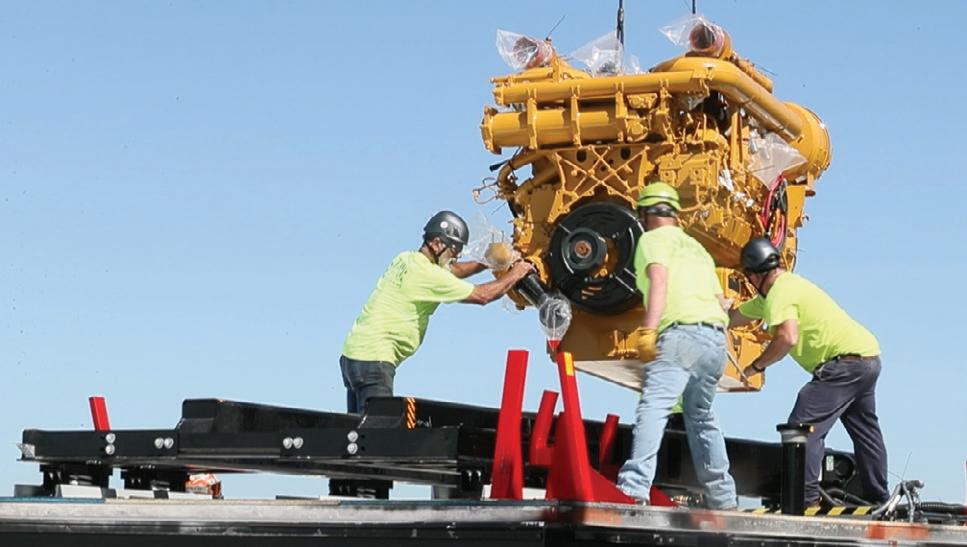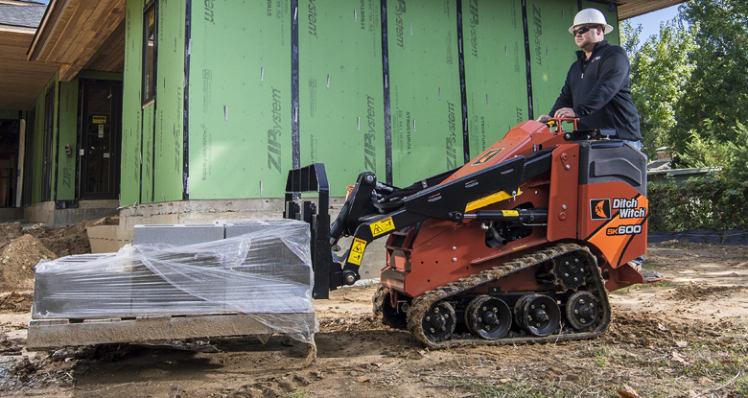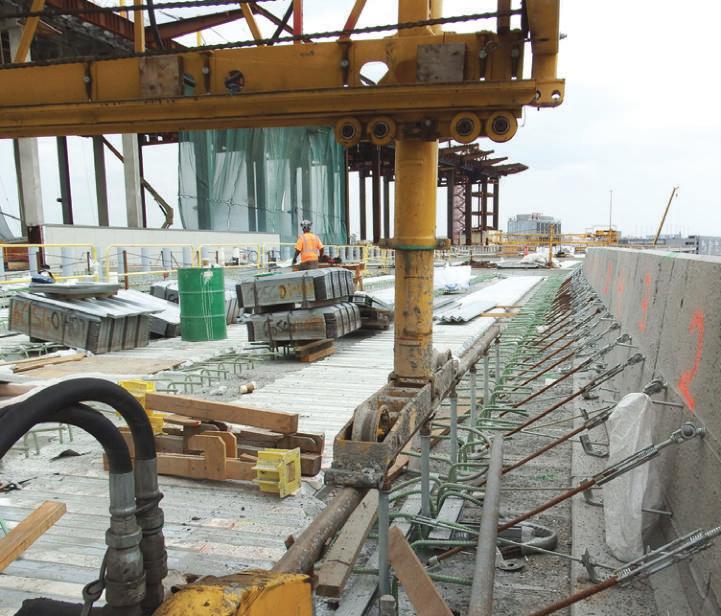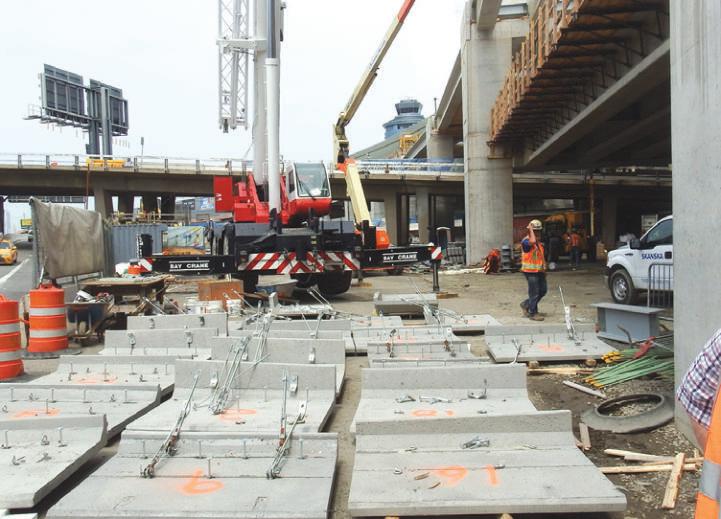
16 minute read
JLG’S NEXT GEN AUGMENTED REALITY APP NOW AVAILABLE
JLG Industries Inc. announced updates to the JLG Augmented Reality (AR) app, giving the digital tool a facelift and expanding its capabilities to be even more useful to users on a day-to-day basis.
The next-generation upgrades include an allnew interface and experience, new content, cloud-based and offline use, expanded machine inspections functionality and a new “Fleet” feature.
“This new, expanded version of the JLG AR app not only has a more modern look and feel, but it also operates more effectively and efficiently,” said Ara Eckel, director of product management for connected solutions, JLG.
The JLG AR app continues to provide five important functions that increase safety, productivity and efficiency on job sites: 1) Machine Visualization, 2) Accessory Visualization, 3) Operation Guidance, 4) Decal Viewer and 5) Inspection Assistant.
Upgrades to the app include several performance-enhancing capabilities to these functions, such as a refreshed mobile application interface and experience that starts at the machine level, allowing users to select a product and go directly into its content module from either the easy-to-use menu guide or through the app’s improved search functionality.
New machines and content also have been added to the equipment modules offering users today more than 60 models to view and manipulate in 3-D.
Content is now cloud-based, rather than native, to reduce the application’s size from 1.3 GB to 227 MB and enhance accessibility to new and updated content. And, the inspection assistance functionality has expanded to cover annual machine inspections, daily machine inspections and pre-delivery inspections.
The new “Fleet” feature helps JLG customers optimize their fleet management right from the app. Users can now add and store multiple assets for easy tracking by serial number/asset ID. And, users can save data on machines and access it instantly, regardless of connectivity.
“Using the JLG AR app, users can get ondemand, digital access to information specific to a machine without ever leaving the job site,” said Eckel.
Examples of this are: • Project managers using the app’s machine visualization can make sure the equipment they’re ordering will fit in their workspace and reach the required areas without looking up dimensions in a manual or online. • Rental companies using the app’s accessory visualization can be confident that they’re ordering the right accessories to fit the models they carry without referencing a parts manual to verify fit. • Before machine use, operators using the app’s operation guidance can see an overlay of a machine’s control panel with explanations of control functions. And, using the decal viewer, operators can scan decals and read them in their native language. • Technicians using their phones can walk through the inspection assistant to ensure they are following proper protocols and efficiently documenting every step.
The new JLG Augmented Reality app is now live in the Apple App Store and available for download. Current app users can easily update to the new version from the same download. The upgraded app will soon be available for download in the Google Play Store.
For more information, visit jlg.com/augmentedreality.
Upgrades to the app include several performance-enhancing capabilities to these functions, such as a refreshed mobile application interface and experience that starts at the machine level, allowing users to select a product and go directly into its content module from either the easy-to-use menu guide or through the app’s improved search functionality.

A Montano Co., Inc. www.amontanoco.com 571 Route 212 • Saugerties, NY 12477 845.247.0206

All Island Equipment www.allislandequipment.com 39 Jersey St. • West Babylon, NY 11704 631.643.2605
Butler Equipment www.butlerequip.com 631 New Park Avenue • West Hartford, CT 06110 860.233.5439
Chappell Tractor www.chappelltractor.com 454 Route 13 South • Milford, NH 03055 603.673.2640 251 Route 125 • Brentwood, NH 03833 800.616.5666 391 Loudon Road • Concord, NH 03301 800.358.6007
George & Swede Sales & Service www.georgeandswede.com 7155 Big Tree Rd. Pavilion (Buffalo/Rochester), NY 14525 585.584.3425
Highway Equipment Company www.highway-equipment.com 22035 Perry Highway • Zelienople (Pittsburgh), PA 724.452.7800 Dubois, PA 15801 814.371.3600

Lorusso Heavy Equipment, LLC www.lhequip.com 160 Elm St. • Walpole, MA 02801 508.660.7600 Modern Group Ltd. www.moderngroup.com 2501 Durham Rd. • Bristol, PA 19007 800.866.3376 Allentown, PA 18106 610.398.1101 York, PA 17406 800.866.3376 Edison, NJ 08837 800.866.3376 Hasbrouck Heights, NJ 07604 201.288.1441
Quality Fleet Service, Inc. www.qualityfleetservice.com 548 New Ludlow Road • South Hadley, MA 01075 413.213.0632
Seaview Equipment LLC www.seaviewequipment.com 640 Crescent Ave. • Bridgeport, CT 06608 203.330.0130
TB Equipment & Rental www.tbequipment.net 892 Odlin Rd. • Bangor, ME 04401 207.262.0014
Tracey Road Equipment, Inc. www.traceyroad.com 6803 Manlius Center Rd. • East Syracuse, NY 13057 315.437.1471 • 800.872.2390 Adams Center, NY 315.788.0200 • 888.335.0200 Albany, NY 518.438.1100 • 866.740.8853 Kirkwood, NY 607.775.5010 • 800.370.9488 Queensbury, NY 518.793.9688 • 800.872.2390 Utica, NY 315.765.8746 • 800.872.2390
Shafer Equipment, LLC www.shaferequipmentwv.com 141 Campbell’s Creek Drive • Charleston, WV 25306 304.548.4300
3-2605

www.andersonequip.com
18 Gorham Industrial Pkwy Gorham, ME 04038 207/591-5482 142 Target Industrial Circle Bangor, ME 04401 207/942-0177 4176 Route 417 Allegany, NY 14706 716/372-8822 720 E Franklin Street Endicott, NY 13760 607/748-3400 115 Middle Road Henrietta, NY 14467 585/334-6770
2140 Military Road Tonawanda, NY 14150 717/877-1992 6317 Thompson Road Syracuse, NY 13206 315/463-8673 912 Albany Shaker Road Latham, NY 12110 518/785-4500 151 Packard Road East Montpelier, VT 05651 802/223-9689 1 Andy’s Way South Charleston, WV 25309 304/756-2800 www.chadwick-baross.com
10 Fox Hollow Road Oxford, CT 06478 203/200-8637 67 McGuire Road South Windsor, CT 06074 860/761-0381 15 Katrina Road Chelmsford, MA 01824 978/479-1524 31 James P Murphy Ind. Hwy West Warwick, RI 02893 844/238-7673 www.chappelltractor.com

454 Route 13 South Milford, NH 03055 603/673-2640 251 Route 125 Brentwood, NH 03833 800/616-5666 391 Loudon Road Concord, NH 03301 800/358-6007 www.allislandequipment.com
39 Jersey Street West Babylon, NY 11704 631/643-2605
www.GroffTractor.com www.medicoce.com
3647 Shafer’s Schoolhouse Rd. Stroud Township, PA 18360 570/420-0877
1500 Highway 315 Wilkes-Barre, PA 18702 800/633-0027
www.gtmidatlantic.com
The helicopter held its position above the building while the rooftop team firmly stood their ground under the intense downdraft and guided the swaying sections into place.


All eight sections were up on the roof within six hours of initial set up.
LIFT from page 76 closed, and officers redirected traffic around the helicopter zone.
The team had received a special FAA permit as the helicopter picked up the generator segments in front of the Massachusetts State House and flew them over the building which is in a no-fly zone. The top two floors of the State House had to be shut down during the flight. The numerous statutes and murals around the State House had to be covered to protect them from any debris that would be pushed up by the helicopter’s strong downdraft and a contractor had to take down their scaffolding in the area so it would not blow over.
A 240,000 sq. ft. area in the Boston Common near the Frog Pond was closed to act as a landing pad and refueling station. With loads of 15,000 lbs., fuel consumption was a concern. The helicopter could only fly for about an hour before needing to refuel, so the team had to work as efficiently as possible. Everything went according to the plan and the helicopter only refueled once.
Set up began at 5:00 a.m. on the day of the lift and the flight began around 8:00 a.m. As the helicopter pilot hovered over the roof with the generator segments, the rooftop team firmly stood their ground under the intense downdraft and guided the swaying sections into place. All eight sections were up on the roof within six hours of initial set up.
“Working with Milton CAT on this project was superior. From making sure it was taken apart right to putting it back together on the roof, Milton CAT was there through the entire project,” John Hobson, senior project manager at Colantonio, said.
After the entire generator was assembled on the roof, Milton CAT began the startup and commissioning of the generator, which includes live testing. Milton CAT also will be supporting and servicing the generator throughout Caterpillar’s two-year warranty.
“The whole operation was a 110 percent success, and I can say that in full confidence,” Hobson explained. “This project was a culmination of my 35 years in the industry. Our success cannot be contributed to any one individual. It took a whole team to make this project come together. Communicating constantly and getting everyone on the same page through multiple meetings is why we got the lift done properly within six hours and without any issues.” (All photos courtesy of Milton CAT)



M O R E H O R S E S

F O R M O R E C H O R E S .
Of gniref snezod fo -kciuq egnahc ta tnmehcat ,s ctiD h ®hctiW tcampoc
tilitu tnmepiuqy e y e rep fr oebmug nnizamn as amrof r og nn as a erohc fd onie khh ttis w d oe kh ts w
reptut oahr tewop eh. Tnoititepme cohs tmrof s woe l - enihcae mcnanetniam s
edivorp eht rev s ta tili y dna tilibailem rret-gnol tahy t latner einapmco s dna

lareneg rotcartnco s dnamer duodnamed . Y si ruo c .dnammco

ER’WE NI SITH TO .RETHGE


.jescoditwww hwtc h.itc us South Plain elfi ld, NJ // 811 St Nicholas
:T 908-753-8080 // F: 908-753-7853 .evA

weShr ursb , MA ,y //
wnoMiddlet , DE // 95 508-71 -0200 3002 6-37 -0784

Beacon, NY // 845-8 800-1831 Deer arP
k, Y NY airF efi ld, NJ / //
Lumber on,t J NJ //
844-482 0-091 973- -2221 -227 // 800- -7070241

©2 810 The ahC elr s aM hc ni e oW rks n, I .c



Questions Linger About Impact of New ELDT Rule
RULE from page 90 have to pay your employee to be out of the office for that time.”
Traditionally, Ditch Witch offered employees the opportunity for on-the-job training.
But what Ridens finds the most frustrating for both employer and driver is the training phase of the entire process.
Though there are obvious benefits to instruction, the inconsistent programming structure is a huge burden, he believes.
He compares the licensing rule with that of recreational vehicles: The driver of a huge boat or large camper can operate it regulation-free as long as the vehicle doesn’t have a DOT number on it, he said.
“And how are employees spending those eight hours a day for 10 weeks in training?” he wondered. “That’s $30 an hour for 10 weeks. What if they leave me in six months? Do they pay it back?” Ripple Effect
Ridens also is concerned about the employees who aren’t tech but drive a truck daily as part of their jobs.
This is Ditch Witch’s scenario, but companies in all parts of the construction equipment industry will be affected the same way.
Ridens predicts the rule will hinder pay increases for some techs who’ll need to register for training. It’ll also limit the number of CDL drivers on a staff.
On the sales side, it’ll hinder workers showing and towing equipment because they don’t have a CDL license.
Some schools are booking up into November in order to get drivers trained for their licenses, he said.
“Until he’s in class, the tech is working, but he can’t drive a truck. And that sales guy? He’s still working his territory, but with another person to help tow equipment until he can get a CDL,” Ridens said. Worth the Trouble?
“This has been a long-time coming,” said the ATA’s Horvath.
The new ELDT was first mandated by Congress back in 2012 before the rulemaking process at the state and federal levels caused years of delay.
According to the FMCSA, the regulations and the registry were mandated under the Moving Ahead for Progress in the 21st Century Act.
This past December, Horvath maintained that “not much” was changing for organizations that have a structured CDL training program in place.
Since its implementation in February of this year, the rule has forced companies that use Class A vehicles to quickly rethink their CDL training programs, said Ridens.
As an equipment manufacturing and sales company representative, Ridens has a different perspective.
A board member of the Illinois Equipment Distributors, he said the organization decided it should study the effects the rule would have on members.
“This is a nationwide story that will impact many individuals in different positions within our independent distributors,” said Tom Stern, the organization’s executive secretary.
Ridens has many other questions about the rule: If an employee doesn’t pass his CDL test, is there a test retake fee?
And will the training program actually discourage potential employees from choosing a career driving in the construction equipment industry?
“Somebody who has to go through a 10week course might choose another career field,” he said. “This just makes it more of a challenge to hire people in the market we’re in right now.” CEG
PRECASTEEL from page 8 slip form a full-scale mock-up at the Lehighton, Pa., facility of its precast supplier, J&R Slaw. It also had to clear the design review process under the scrutiny of WSP USA and HOK.
LaGuardia was challenging on several levels. It was a large project requiring approximately 1,800 linear ft. of SIPFF panels for two structures, each with nine 100-ft. spans of varying soffit widths and two spans with curvature. It also required a deviation from the standard shape. The architect wanted a “Lazy L” shape for aesthetic reasons.
The placement of light blisters also required the soffits to be bumped out from 30 to 44 in. The fact that one bridge used prestress concrete Bulb T Beams and the other steel girders wide flange beams also required Precasteel to modify hardware during the project to accommodate the geometry of the two different bridge beam types.
The Precasteel design allowed for a ¼-in. gap between panels to provide some construction tolerances since no closure pours were allowed on the structures to avoid contrasts in color. It also helped with the camber, which is essentially the upward deflection built into the bridge beam during fabrication. The camber was necessary for the structure to lay level after the entire deadload was applied.
Dinmore confirmed that the gap closed and the panels settled into position along the beams’ edge without consequence when Skanska-Walsh poured the deck.
One unexpected benefit was that the gap was hidden in the shadows of the chamfered edges upon completion, which made the façade even more aesthetically pleasing.
The gap also eliminated rework and scheduling issues for Skanska-Walsh. In one instance, a panel was damaged prior to installation and needed to be replaced. The crew was able to continue setting panels, butting them tightly together, and skipping over the damaged panel location until a new one could be installed. They used a flat bar to make some minor adjustments to adjacent panels and the final panel fit perfectly.
“You don’t have to stop just because you don’t have one piece of the puzzle,” said Dinmore. “That ¼-inch gap helped. It gave the contractor plenty of room to drop it in without banging against the other panels.” Deviating From Original Design
Precasteel was originally designed with a 90-degree angle. The architect at LaGuardia, however, was going for a different aesthetic. The vertical axis tilts back as a result, which Dinmore dubbed the “lazy L.”
Aesthetics are, in fact, what drove the specification of Precasteel over conventional methods at LaGuardia. The tilted back panel would have required extra bracing, whereas precast concrete was able to be formed without additional costs.
The architect discussed the use of white concrete for the facade, but Precasteel suggested that standard concrete would be a close match. They worked with its precast supplier J&R Slaw to provide samples and it was approved.
Problem With Bridge Brackets
“There are inherent problems with bridge brackets,” said Dinmore. These triangular brackets, consisting of steel and heavy-duty plywood, jut out from the edges of the bridge to provide support during deck construction.

Precasteel photo Precasteel allows the paver screed rail to be located along the centerline of the fascia beam as opposed to the panel itself, which eliminates the paving quality issues that can occur when using bridge brackets.

see PRECASTEEL page 100











